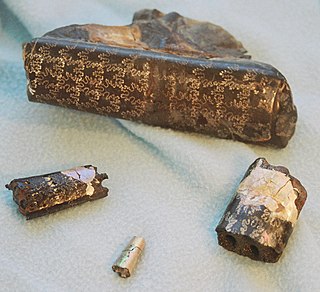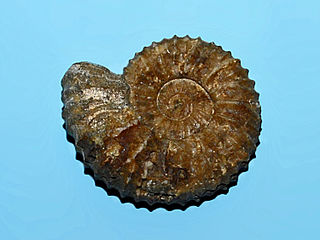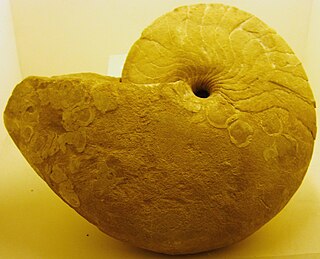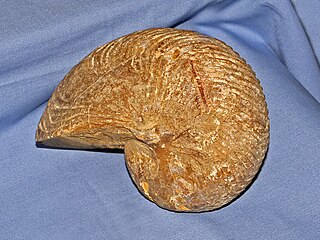
Ammonoids are extinct spiral shelled cephalopods comprising the subclass Ammonoidea. They are more closely related to living coleoids than they are to shelled nautiloids. The earliest ammonoids appeared during the Devonian, with the last species vanishing during or soon after the Cretaceous–Paleogene extinction event. They are often called ammonites, which is most frequently used for members of the order Ammonitida, the only living group of ammonoids from the Jurassic up until their extinction.

The nautilus is an ancient pelagic marine mollusc of the cephalopod family Nautilidae. The nautilus is the sole extant family of the superfamily Nautilaceae and the suborder Nautilina.

The Nautilida constitute a large and diverse order of generally coiled nautiloid cephalopods that began in the mid Paleozoic and continues to the present with a single family, the Nautilidae which includes two genera, Nautilus and Allonautilus, with six species. All told, between 22 and 34 families and 165 to 184 genera have been recognised, making this the largest order of the subclass Nautiloidea.

Nautiloids are a group of marine cephalopods (Mollusca) which originated in the Late Cambrian and are represented today by the living Nautilus and Allonautilus. Fossil nautiloids are diverse and speciose, with over 2,500 recorded species. They flourished during the early Paleozoic era, when they constituted the main predatory animals. Early in their evolution, nautiloids developed an extraordinary diversity of shell shapes, including coiled morphologies and giant straight-shelled forms (orthocones). Only a handful of rare coiled species, the nautiluses, survive to the present day.

Baculites is an extinct genus of heteromorph ammonite cephalopods with almost straight shells. The genus, which lived worldwide throughout most of the Late Cretaceous, and which briefly survived the K-Pg mass extinction event, was named by Lamarck in 1799.
The Nautilina is the last suborder of the Nautilida and the only nautiloids living since the end of the Triassic. The Nautilina, proposed by Shimanskiy, is basically the Nautilaceae of Kummel, 1964, defined by Furnish and Glenister, but differs in omitting two families, the Paracenoceratidae and Pseudonautilidae which instead are placed in the Liroceratina.

Nautilus is a genus of cephalopods in the family Nautilidae. Species in this genus differ significantly in terms of morphology from those placed in the sister taxon Allonautilus. The oldest fossils of the genus are known from the Late Eocene Hoko River Formation, in Washington State and from Late-Eocene to Early Oligocene sediments in Kazakhstan. The oldest fossils of the modern species Nautilus pompilius are from Early Pleistocene sediments off the coast of Luzon in the Philippines.

Obinautilus is an extinct genus of shelled cephalopod that has been variously identified as an argonautid octopod or a nautilid. It is known from the Late Oligocene to Pliocene of Japan. The shell is discoidal and very involute, with rapidly expanding and compressed whorls, fine radial ribs, a rounded venter with a shallow furrow, and almost closed umbilicus.

Ammonitina comprises a diverse suborder of ammonite cephalopods that lived during the Jurassic and Cretaceous periods of the Mesozoic Era. They are excellent index fossils, and it is often possible to link the rock layer in which they are found to specific geological time periods.

Pavlovia is an extinct genus of ammonite of the Late Jurassic to Late Cretaceous.

Aturia is an extinct genus of Paleocene to Miocene nautilids within Aturiidae, a monotypic family, established by Campman in 1857 for Aturia Bronn, 1838, and is included in the superfamily Nautilaceae in Kümmel 1964.
Endolobus is an extinct genus from the nautiloid order, Nautilida. Nautiloids are a subclass of shelled cephalopods that were once diverse and numerous but are now represented by only a handful of species, including Nautilus. Endolubus is included in the family Koninckioceratidae which is part of the superfamily Tainoceratoidea.
Valhallites is an extinct genus in the nautiloid order Nautilida which includes the living Nautilus found in the tropical western Pacifiic. Valhalites belongs to the Koninckioceratidae, a family in the Tainoceratoidea, a nautilid superfamily.

Hercoglossidae is a family of nautilid cephalopods in the superfamily Nautilaceae. It was established by Spath in 1927 for smooth, involute nautiloids characterized by a suture with differentiated elements, known from the Upper Jurassic to the Oligocene.

The Trigonoceratoidea are a superfamily within the Nautilida that ranged from the Devonian to the Triassic, thought to have contained the source for the Nautilaceae in which Nautilus is found.

The Nautilaceae form one of five superfamilies that make up the Nautilida according to Bernard Kummel (1964), and the only one that survived past the Triassic. The Nautilaceae comprise six families: Nautilidae, Paracenoceratidae, Pseudonautilidae, Cymatoceratidae, Hercoglossidae, and Aturiidae. Shimanskiy (1957) separated the Paracenoceratidae and Pseudonautilidae from his near equivalent Nautilina and added them to the Lyroceratina, expanding the equivalent Clydonautiloidea and bringing it into the Jurassic. The Nautilaceae are represented by Nautilus and Allonautilus, genera included in the Nautilidae.

The Cymatoceratidae is a family of Mesozoic and early Cenozoic nautiloid cephalopods and the most abundant of this kind in the Cretaceous. They are characterized by ribbed, generally involute shells of varied form - coiled such that the outer whorl envelops the previous, as with Nautilus, and sutures that are variably sinuous.

Phylloceras is an extinct genus of ammonoid cephalopods belonging to the family Phylloceratidae. These nektonic carnivores lived from Early Jurassic to Late Cretaceous.
Pseudonautilidae is a family of Jurassic and Lower Cretaceous nautilid cephalopods belonging to the same superfamily as modern Nautilus, Nautilaceae, but forming a different branch from the family Nautilidae. Pseudonautilids, together with other nautilids, were contemporary with the ammonoids, which comprise an entirely different set of shelled cephalopod stocks more closely related to octopus and squid.
This list 2019 in paleomalacology is a list of new taxa of ammonites and other fossil cephalopods, as well as fossil gastropods, bivalves and other molluscs that are scheduled to be described during the year 2019, as well as other significant discoveries and events related to molluscan paleontology that are scheduled to occur in the year 2019.
















